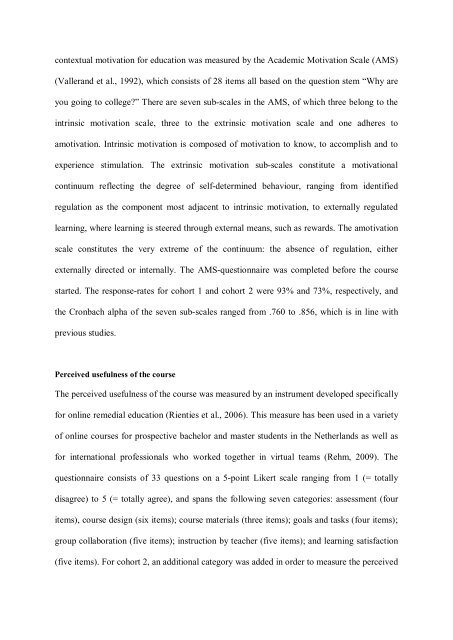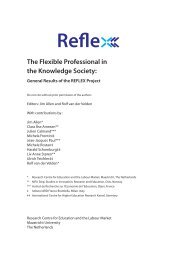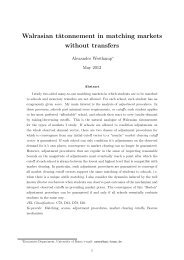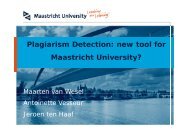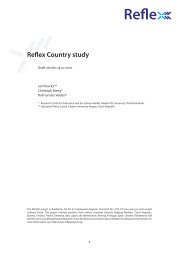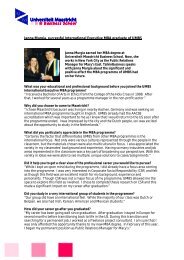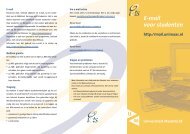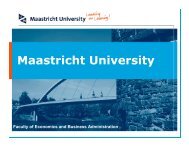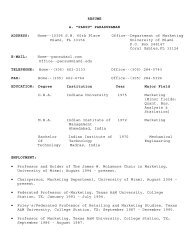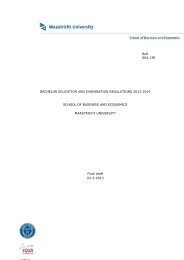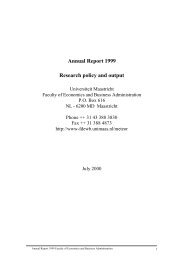Title: Arial, 14 pt - School of Business and Economics - Maastricht ...
Title: Arial, 14 pt - School of Business and Economics - Maastricht ...
Title: Arial, 14 pt - School of Business and Economics - Maastricht ...
You also want an ePaper? Increase the reach of your titles
YUMPU automatically turns print PDFs into web optimized ePapers that Google loves.
contextual motivation for education was measured by the Academic Motivation Scale (AMS)<br />
(Valler<strong>and</strong> et al., 1992), which consists <strong>of</strong> 28 items all based on the question stem “Why are<br />
you going to college?” There are seven sub-scales in the AMS, <strong>of</strong> which three belong to the<br />
intrinsic motivation scale, three to the extrinsic motivation scale <strong>and</strong> one adheres to<br />
amotivation. Intrinsic motivation is composed <strong>of</strong> motivation to know, to accomplish <strong>and</strong> to<br />
experience stimulation. The extrinsic motivation sub-scales constitute a motivational<br />
continuum reflecting the degree <strong>of</strong> self-determined behaviour, ranging from identified<br />
regulation as the component most adjacent to intrinsic motivation, to externally regulated<br />
learning, where learning is steered through external means, such as rewards. The amotivation<br />
scale constitutes the very extreme <strong>of</strong> the continuum: the absence <strong>of</strong> regulation, either<br />
externally directed or internally. The AMS-questionnaire was completed before the course<br />
started. The response-rates for cohort 1 <strong>and</strong> cohort 2 were 93% <strong>and</strong> 73%, respectively, <strong>and</strong><br />
the Cronbach alpha <strong>of</strong> the seven sub-scales ranged from .760 to .856, which is in line with<br />
previous studies.<br />
Perceived usefulness <strong>of</strong> the course<br />
The perceived usefulness <strong>of</strong> the course was measured by an instrument developed specifically<br />
for online remedial education (Rienties et al., 2006). This measure has been used in a variety<br />
<strong>of</strong> online courses for prospective bachelor <strong>and</strong> master students in the Netherl<strong>and</strong>s as well as<br />
for international pr<strong>of</strong>essionals who worked together in virtual teams (Rehm, 2009). The<br />
questionnaire consists <strong>of</strong> 33 questions on a 5-point Likert scale ranging from 1 (= totally<br />
disagree) to 5 (= totally agree), <strong>and</strong> spans the following seven categories: assessment (four<br />
items), course design (six items); course materials (three items); goals <strong>and</strong> tasks (four items);<br />
group collaboration (five items); instruction by teacher (five items); <strong>and</strong> learning satisfaction<br />
(five items). For cohort 2, an additional category was added in order to measure the perceived


